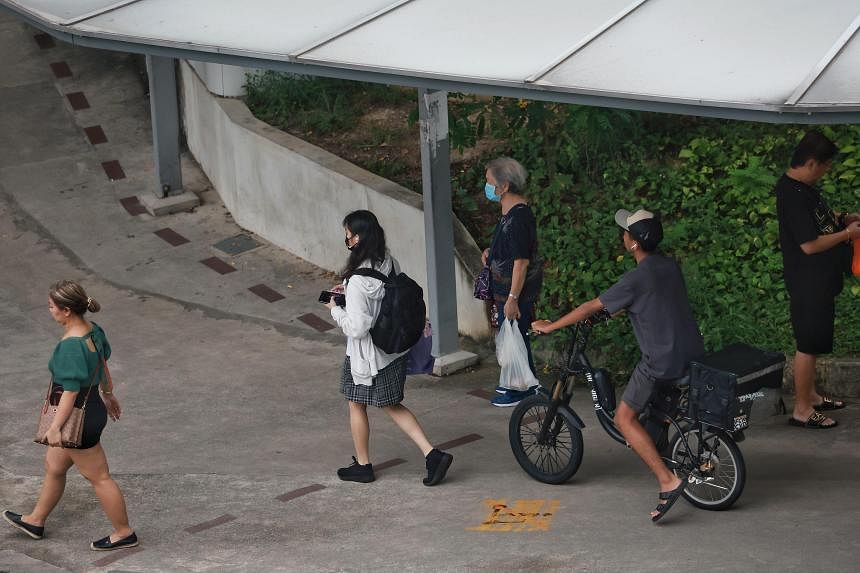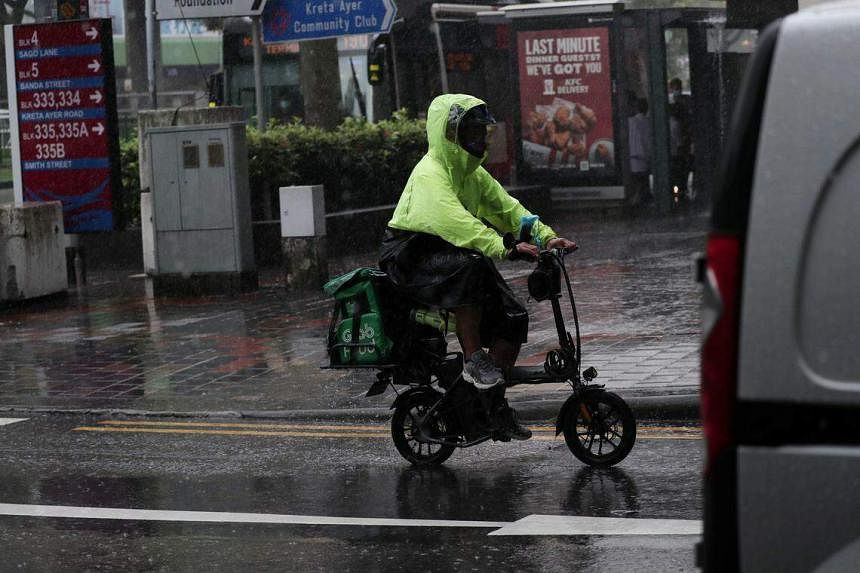S’pore e-bike accidents on the rise amid increase in riders
Road traffic accidents involving e-bikes have doubled from 78 in 2020 to 157 in 2022. ST PHOTO: KEVIN LIM
Esther Loi
SEP 7, 2023
SINGAPORE - The number of power-assisted bicycles – or e-bikes – registered in Singapore has more than doubled in the last few years, surging from about 16,000 in 2020 to 37,320 as at end-June 2023.
Figures released by the Ministry of Transport and Land Transport Authority (LTA) showed that the number of registered e-bikes had increased to 33,453 in 2021, and to 37,000 in 2022.
Transport experts cited a surge in riders using e-bikes for deliveries during the Covid-19 pandemic, the affordability of such vehicles, and better cycling connectivity as reasons behind the increase.
As the number of e-bikes soared, the number of road traffic accidents involving such vehicles has also risen.
The Traffic Police told The Straits Times that there were 157 accidents involving e-bikes in 2022, up slightly from 150 in 2021 but doubling from 78 in 2020.
Of these accidents, some were fatal: three in 2020, another three in 2021, and two in 2022. More recently, in August, a 64-year-old e-bike rider
died after being hit by a minibus in Hougang.
E-bikes remain the preferred transport option for food delivery riders without motorcycle licences. Some riders switched to e-bikes after e-scooters were
banned from footpaths in November 2019 to address public safety concerns.
Others use e-bikes – which are allowed on roads and cycling paths, but not footpaths – for short commutes.
Riders interviewed urged other road users to show them more consideration.
Delivery rider Tiong Yeo, 51, said he often has close shaves with cars and most vehicles treat e-bike users like “pests on the road”.
Vehicles often zoom past e-bike users – whose speeds are capped at 25kmh – without keeping a safe distance, he said.
LTA regulations stipulate that the electric motor of the e-bike must be cut off once it reaches 25kmh or when the rider is not pedalling.
Engineer Jostein Lerum, 59, rode an e-bike for five years in cycling-friendly Norway. He has continued the practice since relocating to Singapore about eight months ago.
He said riding an e-bike in Singapore is not for the faint of heart, and called for a better road culture, which includes treating cyclists with more respect.
Ms Sheila Chen, who is in her 30s and between jobs, attributes this hostility from other road users to a lack of familiarity with e-bike rules. As a result, e-bike riders are wrongly perceived to be vying for space or endangering other road users.
Despite the dangers of riding an e-bike, she said it was a “freeing experience” to use it for commutes, compared with squeezing with crowds on public transport.
Riders also raised other common concerns, including the burden of carrying around extra batteries weighing about 1kg each, the inconvenience of shielding their e-bikes from the rain, and the absence of public e-bike charging infrastructure.
No rise in e-bike accidents, say delivery firms
In the food delivery space, firms said they have not observed more accidents involving riders using e-bikes.
In response to ST’s queries, foodpanda said it had not seen a significant increase in accidents involving its delivery partners here, who number in the thousands.
Grab said that in 2022, 99.99 per cent of its rides and deliveries in the region took place without any safety incident. It declined to disclose Singapore-specific numbers or figures for previous years, citing company policy.
Deliveroo said it was unable to comment.
The firms said they encourage safe riding, be it through foodpanda’s system of allowing its riders to split large orders or Grab not imposing delivery time limits.
Meanwhile, the National Delivery Champions Association, which represents food and package delivery workers in Singapore, organises regular e-bike safety workshops.
Its president Goh Yong Wei said it also teams up with LTA on an education programme that includes topics such as safe riding.
E-bike riders currently need to
pass an online theory test – which covers modules on path and road safety, a general code of conduct and safe riding behaviour – before they are allowed on cycling or shared paths.
But some motorists that ST spoke to called for riders to be licensed to make it easier to take to task those who break the rules.
They cited instances of e-bike riders going against traffic and running red lights.
Mr Jimmy Lim, a 50-year-old driver, said e-bike riders often ignore road traffic rules, by speeding dangerously and overtaking cars in a zig-zag manner.
School counsellor Sivarajasingam Raveendran, 64, said he is nervous driving around e-bike riders, as some ride recklessly.
Some pedestrians like Mr Paul Goodwin, a 60-year-old global sourcing manager, said many e-bike users ride at dangerously high speeds on footpaths.
These delivery riders often ride straight up to the entrances of coffee shops and lift landings, without looking out for pedestrians, he added.
Figures from LTA showed that about 3,807 e-bike users were caught riding on footpaths in the first half of this year, compared with 5,380 errant riders who committed the same offence in 2022.
LTA also recorded 371 non-compliant e-bikes from January to June this year. There were 606 such cases in 2022.
E-bikes remain the preferred transport option for food delivery riders without motorcycle licences. PHOTO: ST FILE
Dwindling demand for e-bikes
Notwithstanding the surge in e-bikes in recent years, three retailers told ST that sales had fallen by more than 50 per cent in 2022 and the first half of 2023, compared with 2020.
Mr Daniel Wang, owner of e-bike brand JiMove, said the pick-up in e-bike sales from 2019 could have been due to the ban on riding e-scooters on footpaths. E-scooters are also barred from roads.
But the growth has since stalled as most e-bike users are delivery riders who already own e-bikes, he added.
Moreover, the minority of riders who use e-bikes for commuting may be put off by the dangers of riding on roads, Mr Wang said.
Mr Joseph Poh, owner of bike shop cubeRpedia, said many of his customers have been trying to sell their LTA-approved e-bikes for as little as $100. That is because those who took up delivery work during the pandemic have returned to their office jobs.
New LTA-approved e-bikes cost $1,000 to $2,000 on average.
Mr Poh is hopeful that e-bike sales will rebound, in view of newly approved models with bigger battery capacities.
Transport experts said e-bikes are here to stay, thanks to their cost-effectiveness and improved cycling accessibility islandwide. LTA aims to double the cycling path network to 1,300km by 2030.
Associate Professor Raymond Ong, a transport infrastructure researcher at the National University of Singapore, said users would consider factors such as cost, time and energy expended for their first- and last-mile commutes to and from transport hubs including MRT stations. This makes e-bikes an attractive option.
Cycling, and riding e-bikes by extension, takes people straight to their destination, compared with travelling by bus. It is also cheaper than taking a private-hire car, added Prof Ong.
Dr Samuel Chng from the Singapore University of Technology and Design (SUTD) cited the cost of motorbikes – given high certificate of entitlement prices – as another reason users would turn to e-bikes.
The head of the Urban Psychology Lab at SUTD’s Lee Kuan Yew Centre for Innovative Cities said e-bikes are also less physically demanding to ride than regular bikes.
The experts said e-bikes could play a bigger role in Singapore’s mobility scene, as cycling gathers steam and space constraints mean roads cannot keep expanding.
Hence, it is important, Prof Ong said, for the focus to be on road safety education and footpath enforcement.
This is to “ensure that drivers behave graciously to e-bikes on the road, and to keep e-bikes off pavements”.















